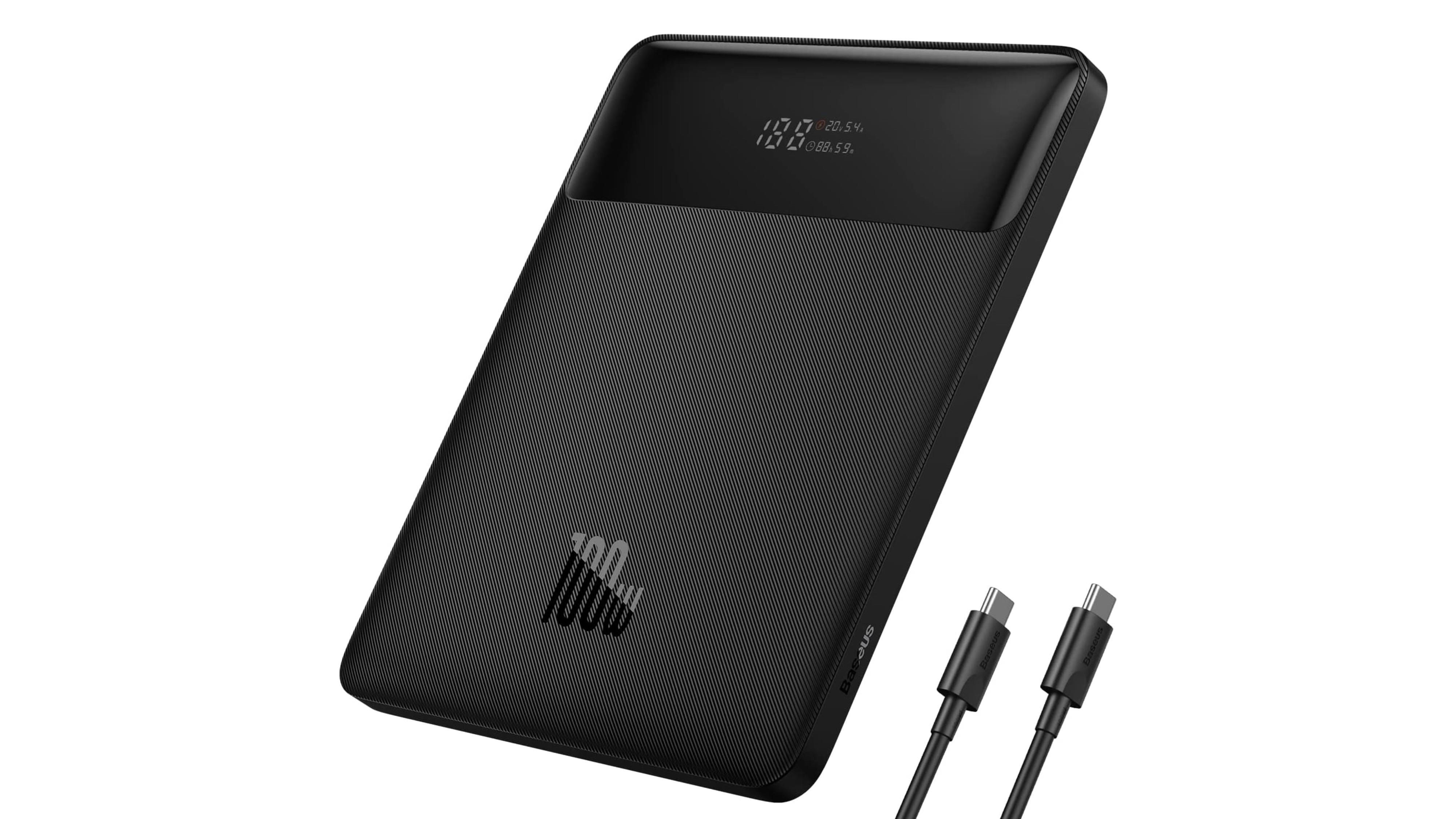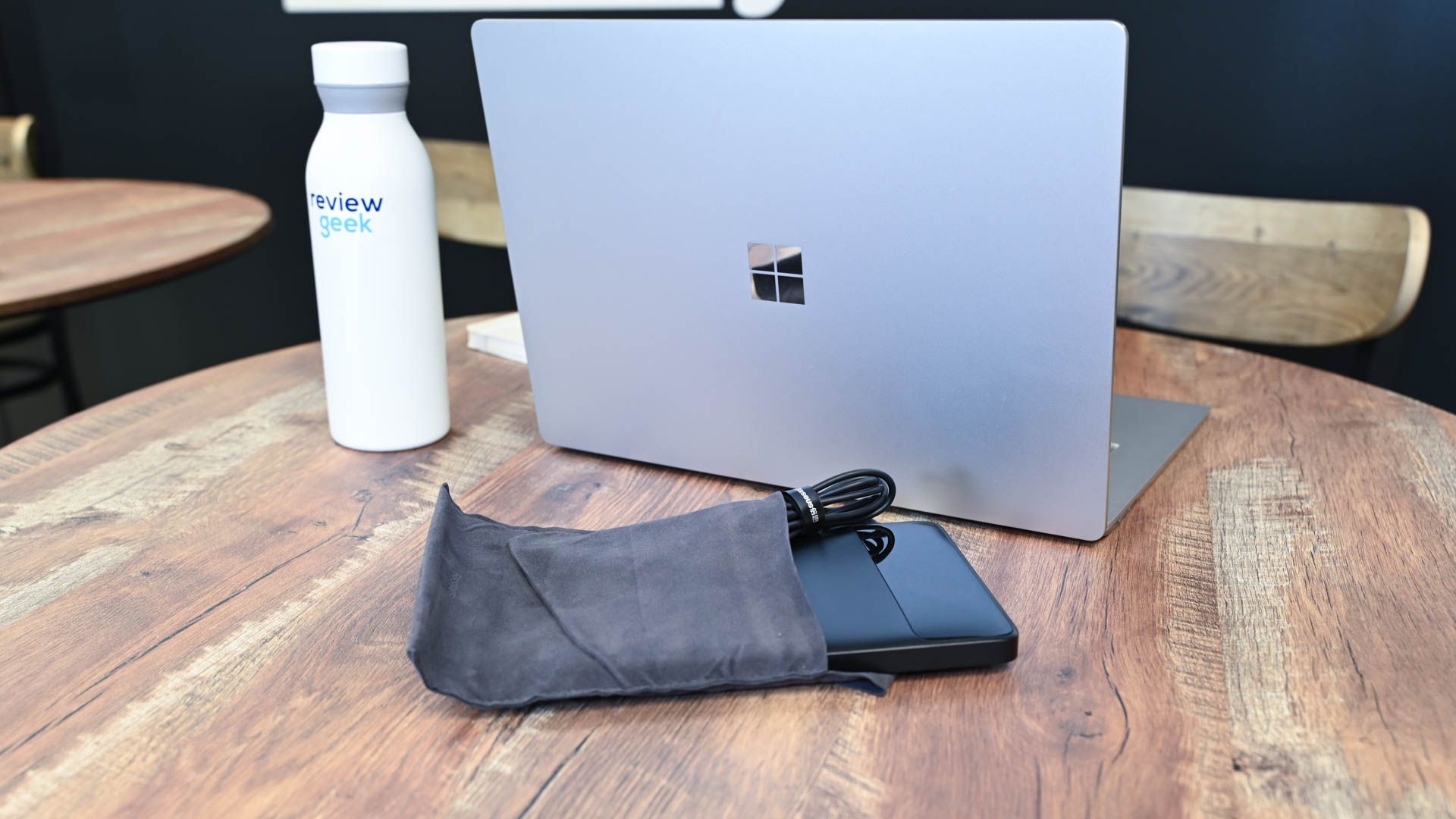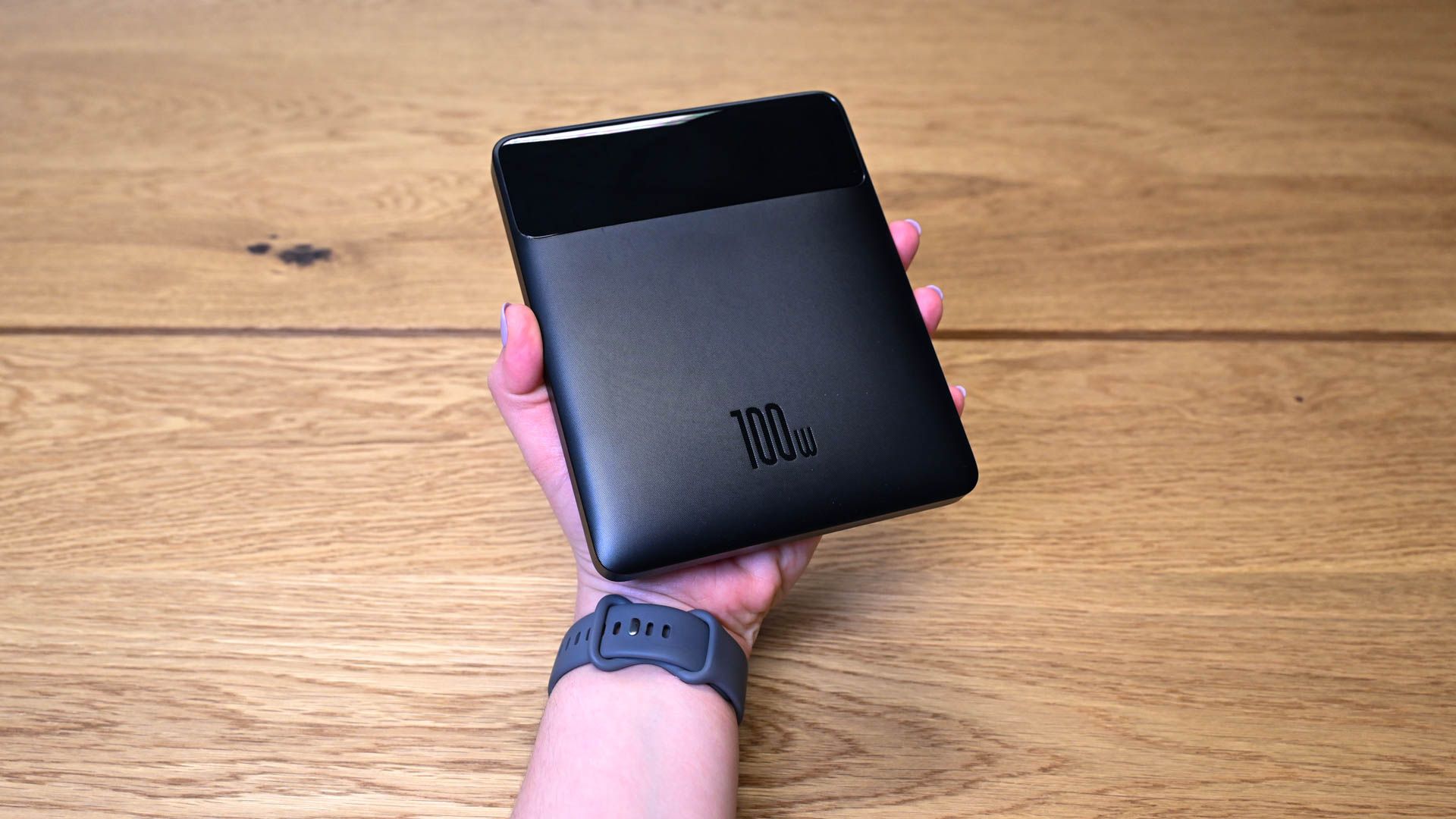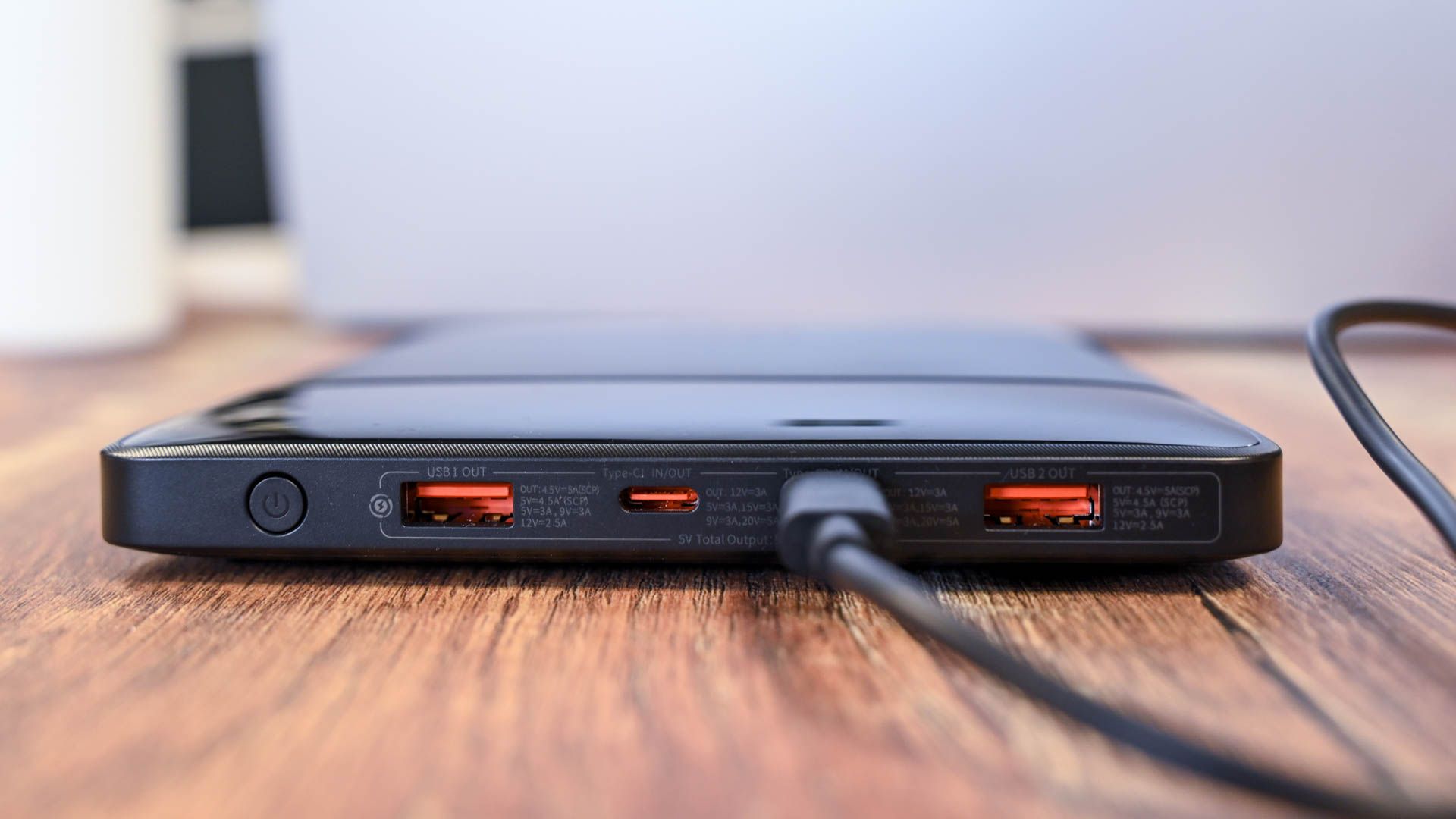Key Takeaways
- The Baseus 100W Laptop Power Bank is a highly portable USB hub with fast-charging capabilities and a sturdy design, making it great for travel.
- The LED display on the power bank provides useful information on battery level, wattage, and time remaining for charging or discharging devices.
- While there are some minor drawbacks like difficulty reading labels and the inability to turn off the display, the overall value and performance of the power bank make it a worthwhile purchase for $130.
The Baseus 100W Laptop Power Bank isn’t your average USB portable battery, in ways both good and not so good. With its 20,000mAh battery and Baseus’ claim that you’ll get up to 100 watts from a single USB-C port, we put the Baseus 100W through some tests to see just how reliable it actually is.

Baseus 100W Laptop Power Bank
Featuring two PD USB-C ports and certified for PD 3.0 and PPS with a power output going up to 100W, the power bank allows you to fast charge your MacBook Pro 16-inch up to 36% in only 30 minutes.
- Brand
- Baseus
- Battery Capacity
- 20,000mAh
- Ports
- 2 USB-C / 2 USB-A
- Weight
- 1.08lbs
- Dimensions
- 6.37 x 5.27 x 0.7in
- Maximum Discharge
- 100W
- Maximum Charge
- 65W
- AC Charge Time
- 1.5 Hours
- Screen
- Digital display
- Flight safe
- Yes
- Fast and powerful charging
- Multiple USB connections
- Good digital display
- Easy to travel with
- Charging results will vary by device and cable used
- No way to turn off the digital display
Design: Take It Wherever You Go
The Baseus 100W Laptop Power Bank is designed for portability, and I wouldn’t hesitate for a second to throw one of these in a travel bag for my next vacation. Measuring 5.27 inches wide, 6.37 inches tall, 0.7 inches from front to back, and weighing only 1.08 pounds, the USB hub is wrapped with a textured industrial plastic and features four rubber stoppers on the bottom of the pack to prevent it from sliding around on sleek surfaces.
An LCD display (more on this below) at the top of the power bank takes up about a quarter of the Baseus’ front-facing area. In terms of USB connectivity, all of your ports are located along the device’s top bezel. There are two USB-C ports, which are both capable of delivering the advertised 100 watts of power, along with two standard 30W USB-A ports. The USB-C ports also double as 67W (max) charging inputs for the power bank itself.
I actually found it rather difficult to understand some of the labelings near the hub’s USB connections and needed to use my iPhone’s flashlight to even make out most of the text. The basic idea is that there are voltage and amperage metrics printed for each individual port, and a total voltage/amperage for all four connections. Up in this part of town, you’ll also see a power button. This acts as a “battery remaining” readout for the Baseus when you press it (with no devices connected).
And in terms of overall gusto, the Baseus 100W rocks a 20,000mAh battery, which is particularly great when it comes time to charge one heavy-duty item (like my MacBook Pro) using USB-C or when you need to charge multiple mobile peripherals, like phones, tablets, and wireless earbuds.
Using the LED Display: Battery, Wattage, and Time Remaining
The Baseus 100W Laptop Power Bank is made for quick plug-and-play operation. Whenever you connect a device that needs recharging (or whenever you charge the Baseus itself), the LCD display at the top-center of the battery bank will activate. The leftmost, largest digit indicates how much power is left in the battery, with values ranging from 100 down to zero.
When you’re charging a device or the hub itself, you’ll see two sets of digits on the right side of the screen. The top row represents voltage and amperage (which can be multiplied for wattage). The bottom shows an hours-and-minutes readout of how long it will take for the Baseus battery to be depleted (when charging a device) or how long it will take for the battery to be juiced back up (when charging the power bank).
Depending on the type of hardware you’re plugging in, you’ll sometimes see a red lightning icon to the left of the voltage-amperage readout. This means that whatever is connected is capable of quick charging. In fact, when connected to a 65W MacBook Pro USB-C power supply (what I used to recharge the Baseus), the Baseus itself indicated that it was utilizing the quick charge protocol.
One thing I wasn’t a big fan of was that whenever an item was plugged in for charging (or whenever I was charging the power bank itself), the display automatically powered on, but you couldn’t shut it off—not even with the power button. The only way to get the display to disappear is to physically unplug all your gear. I guess if you look at it one way, it’s nice to always have an up-to-date readout of battery-in versus battery-out, but I would have appreciated a simple display-off function.
Another slight annoyance is that whenever you’re charging the Baseus, the display blinks, an indication that the hub is being charged (this also happens when there’s less than 10% battery remaining). On the one hand, it’s convenient to know that whenever the readout is blinking, it’s picking up more power. But when you’re using the Baseus in a darker room, the constant LED pulsing can become a little distracting.
Charging Experience: Plenty of Power Across the Board
Throughout the week that I tested the Baseus 100W, I took the opportunity to charge a few different kinds of devices. Let me just say that depending on the gear and connections you’re using, your charging experience will inevitably vary. This is especially true when you’re charging multiple devices at once or charging a single component that’s optimized for USB-C quick charging.
One of the first items I put to the test was the MagSafe Case for my AirPods Pro 2, using a USB-C to Lightning cable. In just 45 minutes, the Baseus took the case from 20% battery all the way up to 70%, and that was without any kind of quick charging whatsoever.
Baseus claims that the power bank should be able to add up to 36% more battery to a MacBook Pro with as little as 30 minutes of charge time (using USB-C). I found this to be pretty accurate, although this will vary based on whether or not you’re using the computer (the same goes for phones and tablets). In my case, I was actively web browsing and using the Notes app during the charge cycle.
When I first plugged my MacBook in, my battery was at 66%. After about 45 minutes, my computer had increased to 87% battery, and I had only used about 15% of the Baseus’ battery capacity. I’m assuming that if I hadn’t been actively using my MacBook, the results would have been even better.
I did have a bit of an odd experience when I had an iPhone 12 and MacBook Pro charging at the same time. At first, the voltage/amperage meter and “time left” readout jumped around a little, which was to be expected. But after charging both devices for about 15 minutes, I grabbed the iPhone, which started out at 80% battery, and it had actually decreased to 79%. Fortunately, my computer (which started off at 65%) kept climbing, reaching 70% battery by the end of those 15 minutes.
One thing to keep in mind is that certain devices will draw more (or less) power from your Baseus based on the hardware’s battery life. For something like a modern iPhone, you may notice that the Baseus’ “time left” readout will show lower digits when the phone is first connected but increase as your iPhone pushes past 80% battery.
Now when it comes time to charge the Baseus 100W, you’ll also want to make sure you have a decent USB-C power adaptor on hand because the Baseus doesn’t come with one. I happened to have a MacBook Pro 67W USB-C power supply and used the Baseus-supplied USB-C cable to recharge the USB hub. And at 70% battery, it only took the Baseus around 20 minutes to completely re-juice.
Okay, here’s a hot take: I’m not entirely convinced that the Baseus 100W should have multiple devices connected at once. Yes, it’s certainly capable, but based on my iPhone/MacBook experiment, I would rather wait for a single device to get as much charge as I’d like it to receive, rather than hope that the power bank is capable of delivering a balanced amount of wattage to two (or more) connected components.
Should You Buy the Baseus 100W Laptop Power Bank?
For only $130 (and it’s frequently on sale), the Baseus 100W Laptop Power Bank is an exceptional USB hub with fast-charging inputs and outputs, a solid design, and an easy-to-read digital display. While it would have been nice to get a wattage readout (instead of voltage/amperage) and to receive a USB-C power adaptor in the box, these are minor nitpicks that are easy to overlook when you consider the overall value and performance of the power bank.

Baseus 100W Laptop Power Bank
Featuring two PD USB-C ports and certified for PD 3.0 and PPS with a power output going up to 100W, the power bank allows you to fast charge your MacBook Pro 16-inch up to 36% in only 30 minutes.





